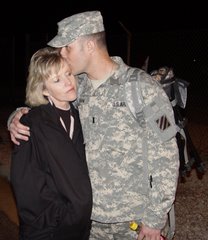
By Sgt. Kevin McSwainFOB HAMMER, Iraq — After doing it only once, Soldiers from Fort Benning, Ga., can build a fire truck in 45 minutes.
Soldiers from Company A, 203rd Brigade Support Battalion, 3rd Heavy Brigade Combat Team, 3rd Infantry Division, were tasked with the mission to establish a firefighting crew to support Forward Operating Base Hammer.
“We were chosen to become the base firefighters because we had the assets to get the job done,” said Capt. Fenicia Jackson, company commander.
Jackson said the unit, which consists of five support platoons, was able to create fire trucks using resources from their transportation and water treatment platoons.
“The two platoons worked together to build the equipment,” she said. “We used a palletized load system from the transportation platoon as a platform to hold water bladders supplied by the water treatment platoon.”
The configuration used to create the truck was the idea of Staff Sgt. Cleveland Randolph and Sgt. Michael Murray, both with the water treatment platoon.
“We sat down and thought about how the system was going to be set up,” said Randolph, platoon sergeant. “Once we put one together, we found that it worked perfectly.”
Randolph said the first fire truck took a few hours to build, but after the design was complete, the process became easy.
“The first day of building was trial and error,” he said. “Now we can have a fire truck built in 45 minutes.”
The platoon has built six trucks so far: three truck are on standby in the company area, two trucks support 3rd Squadron, 1st Cavalry Regiment, and one truck supports 1st Battalion, 15th Infantry Regiment both with 3rd HBCT, 3rd Inf. Div.
“Our trucks are here to support emergencies on base,” Randolph said. “The other trucks are part of our forward deployed units. They provide support to the Soldiers who stay in areas outside of the forward operating base.”
The trucks, designed to be multiple purpose vehicles, allow Soldiers to drink the water inside the systems if needed.
“We wanted to create a water transportation system when we made the fire trucks,” said Murray, water site noncommissioned officer in charge. “Our job is to purify water delivered to us, so it is clean enough to drink.”
Randolph, from Meridian, Miss., said the trucks could carry 1,500 gallons of water.“Each truck has three forward area water point supply systems, which holds 500 gallons of water each,” he said.
The systems are linked together and connected to a pump, which shoots water out of a 10-foot hose.
“The idea the Soldiers came up with was better than I imagined,” Jackson said. “I told them what we needed and they produced a vehicle that can complete the mission and do much more.
”The Soldiers from the water treatment platoon are responsible for maintaining and operating the new equipment.
“No one in our unit has experience fighting fires,” Randolph said. “We are all learning to operate the pump and hose through daily training.”
Different Soldiers operate the equipment on the truck each day to ensure the entire crew is proficient.
“Personnel and time management allowed us to complete this mission as we established the daily operation of our unit,” Jackson said.
In addition to the creation of a firefighting team, the platoon is responsible for the treatment and storage of 600,000 gallons of water on the base.
Jackson said the challenge gave her Soldiers a chance to show how creative they can be to accomplish a mission.
“I was honored to be given such a great challenge,” she said. “This was an opportunity for our Soldiers to show that they are ready to accomplish any mission.”





No comments:
Post a Comment